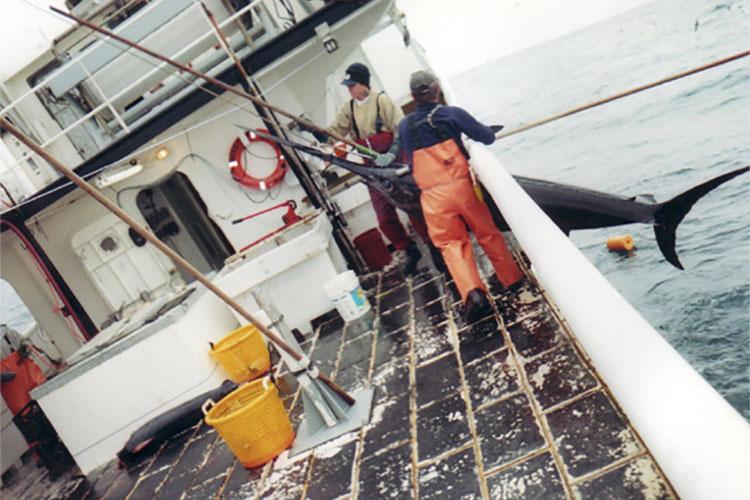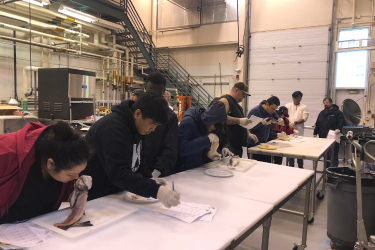What happens to 2018 individual bluefin quota debt in 2019?
Outstanding quota debt from 2018 will carry over to 2019. A vessel will not be allowed to fish beginning January 1, 2019, if there is outstanding quota debt associated with the permit.
Permit holders who do not have the available quota—obtained through direct allocation or leasing—to settle their vessel’s debt will see an equal, automatic deduction in their 2019 allocation. That reduction will remain in effect until the 2018 quota debt is fully settled or the 2019 allocation is fully used.
What about my 2018 individual bluefin quota allocation?
Remaining individual bluefin quota (IBQ) allocation will not carry over to 2019.
How do I resolve my quota debt before 2019?
If a vessel account has quota debt beyond the IBQ allocation in their account, the permit holder must:
- Lease a sufficient amount of allocation from an Atlantic Tunas Longline permit holder or Purse Seine category participant and transfer it into their vessel account.
- Resolve the quota debt transaction(s) in the online IBQ system.
Atlantic pelagic longline quota debt can be resolved using Atlantic allocation, Gulf of Mexico pelagic longline allocation, or purse seine allocation. Gulf of Mexico quota debt can only be resolved using Gulf of Mexico allocation.
An IBQ shareholder can log into their shareholder account to resolve quota debt in their vessel account(s). From the main menu, go to Catches and click Resolve Quota Debt Mid-Year.
Consult page 31 of the Individual Bluefin Quota (IBQ) Troubleshooting Guide, available through the online IBQ system, or call IBQ Customer Service for more information.
What about trips that begin in 2018 and continue into 2019?
Any bluefin catch from a pelagic longline fishing trip that begins in 2018 and ends in 2019 will count against the vessel’s 2019 quota.
How much individual bluefin quota allocation will I have in 2019?
The high, medium, and low share percentages will be equivalent to 4,317 lb, 2,157 lb, and 1,330 lb of annual allocation, respectively.
The annual quota allocation will be dispersed to IBQ shareholders on January 1, 2019, if their Atlantic Tunas Longline permit is associated with a vessel. To determine the amount of IBQ available to you, log into your shareholder account. NOAA Fisheries may subsequently transfer additional bluefin quota from the Reserve category to the Longline category, which could increase a shareholder’s overall allocation.
Remember to renew your permit if it expires soon.
What if I don’t receive an annual individual bluefin quota allocation?
Permit holders who do not receive annual IBQ allocation (does not have IBQ share) may lease IBQ allocation from another permit holder.
A vessel must have the required minimum amount of IBQ allocation— 276 lb in the Atlantic and 551 lb in the Gulf of Mexico—before departing on its first pelagic longline trip in the first quarter of 2019.
Are there restrictions on individual bluefin quota transactions at the end of 2018?
You cannot conduct IBQ transactions beginning 6 p.m. (EST) on December 31 and ending at 2 p.m. (EST) on January 1. This includes leases or transfers among vessel and shareholder accounts. NOAA Fisheries uses this annual maintenance window for system maintenance, end-of-year accounting, and quota disbursement.
Can I still land bluefin and account for dead discards during the maintenance window?
Yes, but the catch will count against the 2019 IBQ allocation.
What else do I need to know for 2019?
REMINDER on Atlantic tunas landing restrictions
For all retained tunas, the upper and lower lobes of the tuna tail may be removed for storage purposes as long as the fork of the tail remains intact. The fork may not be removed even if the remaining carcass meets the minimum size requirements. See 50 CFR 635.30(a) for more information.
As of October 10, 2018, if a bigeye and/or yellowfin tuna carcass has been damaged (i.e., bitten) by a shark or another marine species, it may be retained and landed but the remainder of the fish must still meet the minimum size of 27 in (69 cm). No tissue may be cut away from or other alterations made to the damaged area of the fish.
Electronic monitoring
The electronic monitoring (EM) requirements will remain unchanged from 2018. Please note:
- You are required to maintain the working condition of your EM cameras, which includes cleaning the lens with a clean, wet, soft cloth when salt or other materials accumulate. If the image on the monitor appears blurry, and is not corrected by cleaning the lens, please call Saltwater, Inc., as the problem may be caused by a damaged camera housing or a flooded lens.
- You are required to mail the hard drives at the end of each trip. Monthly mailing of hard drives does not comply with the requirements. Please contact the HMS Management Division with questions.
Vessel monitoring system reporting requirements:
Vessels must submit a Highly Migratory Species Bluefin Tuna Catch Report through VMS for each set. Vessels must report the number of all bluefin discarded dead or retained (by standardized size ranges) within 12 hours of completion of each set, including reporting of zero bluefin on a set.
Online IBQ system
Add your email address under My Account > Update Account to expedite communication with NOAA Fisheries. You’ll be prompted to set up two security questions.
Who do I contact to learn more?
Individual Bluefin Quota Program
- Online IBQ system. To find the Individual Bluefin Quota (IBQ) Troubleshooting Guide, select Additional Information from the system homepage.
- IBQ Customer Service: 301-427-8591 (8 a.m.–5 p.m. EST, Monday-Friday, excluding federal holidays)
Electronic monitoring
- Technical questions about camera system: Saltwater, Inc., 800-770-3241
- Hard drive mailing procedures: Earth Resources Technology, Inc., 240-393-4213
Pelagic Observer Program: 800-858-0624
Vessel monitoring systems: 888-219-9228
SERO Permits Office: 877-376-4877
General information about pelagic longline fishery regulations:
- Amendment 7 webpage; Atlantic Highly Migratory Species Regulations
- HMS Management Division: 978-281-9260 (Brad McHale or Thomas Warren); 301-427-8503 (Craig Cockrell or Carrie Soltanoff); 727-824-5399 (Jennifer Cudney)



